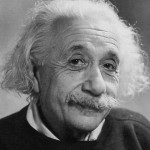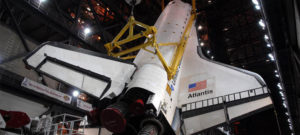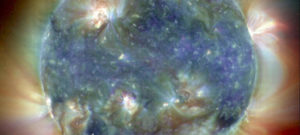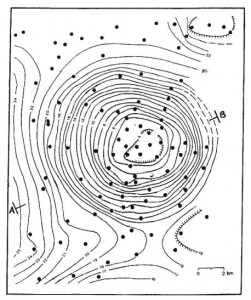
Johannes Kepler, a German mathematician and astronomer in the 1600s, was one of the key players of his time in astronomy. Among his best discoveries was the development of three laws of planetary orbits. He worked for Tycho Brahe, who had logged huge volumes of astronomical data, which was later passed onto to Kepler. Kepler took this information to design and develop his ideas about the movements of the planets around the Sun.
Kepler’s 1st Law states that planetary orbits about the Sun are not circles, but rather ellipses. The Sun lies at one of the foci of the ellipse.
Well, almost.
Newton’s Laws of Motion state that the Sun can’t be stationary, because the Sun is pulling on the planet just as hard as the planet is pulling on the Sun. They are yanking on each other. The planet will move more due to this pulling because it is less massive. The real trick to understanding this law is that both objects orbit around a common point that is the center of mass for both objects. If you’ve ever swung a heavy bag of oranges around in a circle, you know that you have to lean back a bit to balance yourself as you swing around and around. It’s the same principle, just on a smaller scale.
Please login or register to read the rest of this content.

Kepler’s Laws of planetary orbits explain why the planets move at the speeds they do. You’ll be making a scale model of the solar system and tracking orbital speeds.
Kepler’s 1st Law states that planetary orbits about the Sun are not circles, but rather ellipses. The Sun lies at one of the foci of the ellipse. Kepler’s 2nd Law states that a line connecting the Sun and an orbiting planet will sweep out equal areas in for a given amount of time. Translation: the further away a planet is from the Sun, the slower it goes.
Please login or register to read the rest of this content.
If one of Kepler’s Laws describe the orbits of satellites as being an elliptical orbit, you might be wondering what an ellipse is! Here’s a really neat way to make an ellipse using a pencil and a rubber band:
Click here to go to next lesson on Applying Kepler’s Laws.
[/am4show]
An important concept to understand is that a satellite is a projectile, meaning that only the force of gravity is acted on it (once it’s launched). In order to maintain it’s orbit, a satellite needs to fall continuously at the same rate that the earth is curving away from it.
Please login or register to read the rest of this content.
The Hubble Space Telescope (HST) zooms around the Earth once every 90 minutes (about 5 miles per second), and in August 2008, Hubble completed 100,000 orbits! Although the HST was not the first space telescope, is the one of the largest and most publicized scientific instrument around. Hubble is a collaboration project between NASA and the ESA (European Space Agency), and is one of NASA’s “Great Observatories” (others include Compton Gamma Ray Observatory, Chandra X-Ray Observatory, and Spitzer Space Telescope). Anyone can apply for time on the telescope (you do not need to be affiliated with any academic institution or company), but it’s a tight squeeze to get on the schedule.
Hubble’s orbit zooms high in the upper atmosphere to steer clear of the obscuring haze of molecules in the sea of air. Hubble’s orbit slowly decays over time and begins to spiral back into Earth until the astronauts bump it back up into a higher orbit.
But how does a satellite stay in orbit? Try this experiment now:
Materials:
- marble
- paper
- tape
A satellite is an object that does around a planet, a star, or other similar object. Here’s how you can figure out the net force of a satellite as well as the velocity of the satellite, since the only force applied to the satellite is from gravity:
Please login or register to read the rest of this content.
Callisto is one of Jupiter’s moons. Would it be really cool to be able to approximate the size of Jupiter based on watching the motion of Callisto? For example, if you knew how long it took Callisto to orbit around Jupiter, and the furthest distance it traveled away from it (both of which you could measure from a backyard telescope)? Here’s how:
Please login or register to read the rest of this content.
So, here’s a question. If you are “weightless” in space, do you still have mass? Yes, the amount of stuff you’re made of is the same on Earth as it is in your space ship. Mass does not change but since weight is a measure for how much gravity is pulling on you, weight will change. Did you notice that I put weightless in quotation marks? Wonder why?
Please login or register to read the rest of this content.
A binary system exists when objects approach each other in size (and gravitational fields), the common point they rotate around (called the center of mass) lies outside both objects and they orbit around each other. Astronomers have found binary planets, binary stars, and even binary black holes.
The path of a planet around the Sun is due to the gravitational attraction between the Sun and the planet. This is true for the path of the Moon around the Earth, and Titan around Saturn, and the rest of the planets that have an orbiting moon.
Materials
- Soup cans or plastic containers with holes punched (like plastic yogurt containers, butter tubs, etc.)
- String
- Water
- Sand
- Rocks
- Pebbles
- Baking soda
- Vinegar
Today you get to learn how to read an astronomical chart to find out when the Sun sets, when twilight ends, which planets are visible, when the next full moon occurs, and much more. This is an excellent way to impress your friends.
The patterns of stars and planets stay the same, although they appear to move across the sky nightly, and different stars and planets can be seen in different seasons.
Materials:
- Printout of Stargazer’s Almanac
- Pencil
- Tape and scissors (optional)
- Ruler
 What would happen if our solar system had three suns? Or the Earth had two moons? You can find out all these and more with this lesson on orbital mechanics. Instead of waiting until you hit college, we thought we'd throw some university-level physics at you... without the hard math.
What would happen if our solar system had three suns? Or the Earth had two moons? You can find out all these and more with this lesson on orbital mechanics. Instead of waiting until you hit college, we thought we'd throw some university-level physics at you... without the hard math.
Please login or register to read the rest of this content.
 If you watch the moon, you’d notice that it rises in the east and sets in the west. This direction is called ‘prograde motion’. The stars, sun, and moon all follow the same prograde motion, meaning that they all move across the sky in the same direction.
If you watch the moon, you’d notice that it rises in the east and sets in the west. This direction is called ‘prograde motion’. The stars, sun, and moon all follow the same prograde motion, meaning that they all move across the sky in the same direction.
However, at certain times of the orbit, certain planets move in ‘retrograde motion’, the opposite way. Mars, Venus, and Mercury all have retrograde motion that have been recorded for as long as we’ve had something to write with. While most of the time, they spend their time in the ‘prograde’ direction, you’ll find that sometimes they stop, go backwards, stop, then go forward again, all over the course of several days to weeks.
Here are videos I created that show you what this would look like if you tracked their position in the sky each night for an year or two.
Please login or register to read the rest of this content.
Click here to go to next lesson on Potential Energy in the Stars.
In our physics problems so far, we’ve kept the objects close to the earth so that the acceleration due to gravity g remains constant, and we defined the potential energy of an object on the surface of the earth to be zero. What if we look up and see three stars in a system and want to find out the gravitational potential energy of the system?
Please login or register to read the rest of this content.
Here’s how you put it all together and figure out the total energy of the system. This is useful when you’re trying to figure out something that you can’t otherwise solve for… let me show you with a set of videos here. Remember, for satellites the only force we have on the object is due to gravity, so the external work force term always goes to zero like this:
Please login or register to read the rest of this content.

Einstein once said: “I was sitting in a chair in the patent office at Bern when all of the sudden a thought occurred to me: If a person falls freely, he will not feel his own weight. I was startled. This simple thought made a deep impression on me. It impelled me toward a theory of gravitation.”
This led Einstein to develop his general theory of relativity, which interprets gravity not as a force but as the curvature of space and time. This topic is out of the scope for our lesson here, but you can explore more about it in this lesson.
The fundamental principle for relativity is the principle of equivalence, which says that if you were locked up in a box, you wouldn’t tell the difference between being in a gravitational field and accelerating (with an acceleration value equal to g) in a rocket.
The same thing is also true if you were either locked in a box, floating in outer space or in an elevator shaft experiencing free-fall. Any experiments you could do in either of those cases wouldn’t be able to tell you what was really happening outside your box. The way a ball drops is exactly the same in either case, and you would not be able to tell if you were falling in an elevator shaft or drifting in space.
Please login or register to read the rest of this content.

Gravity is the reason behind books being dropped and suitcases feeling heavy. It’s also the reason our atmosphere sticks around and oceans staying put on the surface of the earth. Gravity is what pulls it all together, and we’re going to look deeper into what this one-way attractive force is all about.
Please login or register to read the rest of this content.
One of Newton’s biggest contributions was figuring out how to show that gravity was the same force that caused both objects like an apple to fall to the earth at a rate of 9.81 m/s2 AND the moon being accelerated toward the earth but at a different rate of 0.00272 m/s2. If these are both due to the same force of gravity, why are they different numbers then? Why is the acceleration of the moon 1/3600th the acceleration of objects near the surface of the earth? It has to do with the fact that gravity decreases the further you are from an object. The moon is in orbit about 60 times further from the earth’s center than an object on the surface of the earth, which indicates that gravity is proportional to the inverse of the square of the distance (also called the inverse square law). So the force of gravity acts between any two objects and is inversely proportional to the square of the distance between the two centers. The further apart the objects are, the less they force of gravity is between the two of them. If you separate the objects by twice the distance, the gravitational force goes down by a factor of 4.
Please login or register to read the rest of this content.
All objects are attracted to each other with a gravitational force. You need objects the size of planets in order to detect this force, but everything, everywhere has a gravitational field and force associated with it. If you have mass, you have a gravitational attractive force. Newton’s Universal Law of Gravitation is amazing not because he figured out the relationship between mass, distance, and gravitational force (which is pretty incredible in its own right), but the fact that it’s universal, meaning that this applies to every object, everywhere.
Please login or register to read the rest of this content.
Lord Henry Cavendish in 1798 (about a century after Newton) performed experiments with a torsion balance to figure out the value of G. It’s a very small number, so Cavendish had to carefully calibrate his experiment! The reason the number is so small is because we don’t see the effects of gravity until objects are very massive, like a moon or a planet in size.
Please login or register to read the rest of this content.
How do astronomers find planets around distant stars? If you look at a star through binoculars or a telescope, you’ll quickly notice how bright the star is, and how difficult it is to see anything other than the star, especially a small planet that doesn’t generate any light of its own! Astronomers look for a shift, or wobble, of the star as it gets gravitationally “yanked” around by the orbiting planets. By measuring this wobble, astronomers can estimate the size and distance of larger orbiting objects.
Doppler spectroscopy is one way astronomers find planets around distant stars. If you recall the lesson where we created our own solar system in a computer simulation, you remember how the star could be influenced by a smaller planet enough to have a tiny orbit of its own. This tiny orbit is what astronomers are trying to detect with this method.
Materials
- Several bouncy balls of different sizes and weights, soft enough to stab with a toothpick
- Toothpicks
Weight is nothing more than a measure of how much gravity is pulling on you. This is why you can be “weightless” in space. You are still made of stuff, but there’s no gravity to pull on you so you have no weight. The larger a body is, the more gravitational pull (or in other words the larger a gravitational field) it will have.
The Moon has a fairly small gravitational field (if you weighed 100 pounds on Earth, you’d only be 17 pounds on the Moon). The Earth’s field is fairly large and the Sun has a HUGE gravitational field (if you weighed 100 pounds on Earth, you’d weigh 2,500 pounds on the Sun!).
Please login or register to read the rest of this content.
If you could stand on the Sun without being roasted, how much would you weigh? The gravitational pull is different for different objects. Let’s find out which celestial object you’d crack the pavement on, and which your lightweight toes would have to be careful about jumping on in case you leapt off the planet.
Weight is nothing more than a measure of how much gravity is pulling on you. Mass is a measure of how much stuff you’re made out of. Weight can change depending on the gravitational field you are standing in. Mass can only change if you lose an arm.
Materials
- Scale to weigh yourself
- Calculator
- Pencil
First we’re going to assume the earth is like a ball in that it’s a perfect sphere, and also that the density of the earth is even and it depends only how far from the center of the earth you are. Let’s also assume the earth isn’t rotating. Once we have these things in mind, then the magnitude of the force of gravity acting on an object goes like this…
Please login or register to read the rest of this content.

PRE-K & K
Material properties, introduction to forces and motion, plants and animals, and basic principles of earth science.

First Grade
States of matter, weather, sound energy, light waves, and experimenting with the scientific method.

Second Grade
Chemical reactions, polymers, rocks and minerals, genetic traits, plant and animal life cycles, and Earth's resources.

Third Grade
Newton's law of motion, celestial objects, telescopes, measure the climate of the Earth and discover the microscopic world of life.

Fourth Grade
Electricity and magnetism, circuits and robotics, rocks and minerals, and the many different forms of energy.

Fifth Grade
Chemical elements and molecules, animal and plant biological functions, heat transfer, weather, planetary and solar astronomy.

Sixth Grade
Heat transfer, convetion currents, ecosystems, meteorology, simple machines, and alternative energy.

Seventh Grade
Cells, genetics, DNA, kinetic and potential, thermal energy, light and lasers, and biological structures.

Eighth Grade
Acceleration, forces projectile motion chemical reactions, deep space astronomy, and the periodic table.

High School (Advanced)
Alternative energy, astrophysics, robotics, chemistry, electronics, physics and more. For high school & advanced 5-8th students.

Teaching Resources
Tips and tricks to getting the science education results you want most for your students.

Science Fair Projects
Hovercraft, Light Speed, Fruit Batteries, Crystal Radios, R.O.V Underwater Robots and more!
There are three main differences between assuming the earth is round, uniformly dense, and not rotating as we did before.
 First, the crust is not uniform. There are lumps and clumps everywhere that vary the density add up to make small variations in the force of gravity that we can actually measure with objects in free-fall motion. It’s actually how scientists find pockets of oil in the earth. They measure the surface gravity and plot it out, and if there’s a large enough deviation, it means there’s something interesting underground.
First, the crust is not uniform. There are lumps and clumps everywhere that vary the density add up to make small variations in the force of gravity that we can actually measure with objects in free-fall motion. It’s actually how scientists find pockets of oil in the earth. They measure the surface gravity and plot it out, and if there’s a large enough deviation, it means there’s something interesting underground.
This image of the Mors salt dome in Denmark was studied for radioactive waste disposal. It’s a surface gravity survey that measures the acceleration due to gravity that shows something interesting is underground! The dots are the places where gravity was actually measured. You can read more about how gravity is measured from advanced lecture notes here. The unit of measurement for these deviations is called the “milligal” for Galileo, where 1 gal = 1,000 mgal = 1 cm/s3.
Click here to go to next lesson on The Earth is not a Sphere.
[/am4show]
The second problem with our assumption sis that the earth is not a sphere. It’s flattened a bit at the poles and bulges out at the equator. The ring around equator is larger than a ring around the poles by 21 km, which makes the poles closer to the center of the earth than the equator! Free-fall at the poles is slightly more than free-fall at the equator.
But before you book a trip to skydive in Ecuador, Colombia, Brazil, Sao Tome, Gabon, the Republic of the Congo, the Democratic Republic of the Congo, Uganda, Kenya, Somalia, Maldives, Indonesia or Kiribati, let’s talk about the assumption we made… The earth really does rotate. That’s not a surprise. How does this affect the value of g then? The bottom line is that gravity changes with altitude from 9.78 to 9.84 m/s2., mostly due to the earth spinning, but some to the earth not being a perfect sphere.
Please login or register to read the rest of this content.
Circular motion is a little different from straight-line motion in a few different ways. Objects that move in circles are roller coasters in a loop, satellites in orbit, DVDs spinning in a player, kids on a merry go round, solar systems rotating in the galaxy, making a left turn in your car, water through a coiled hose, and so much more.
Please login or register to read the rest of this content.
For any object that goes in a circle (or you can approximate it to a circle), you’ll want to use this approach when solving problems. You can feel the effect of circular motion if you’ve ever been in a car that suddenly turns right or left. You feel a push to the opposite side, right? If you are going fast enough and you take the turn hard enough, you can actually get slammed against the door. So my question to you is: who pushed you? Let’s find out!
Please login or register to read the rest of this content.
An object that moves in a circle with constant speed (like driving your car in a big circle at 30 mph) is called uniform circular motion. Although the speed is constant (30 mph), the velocity, which is a vector and made up of speed and direction, is not constant. The velocity vector has the same speed (magnitude), but the direction keeps changing as your car moves around the circle. The direction is an arrow that’s tangent to the circle as long as the car is moving on a circular path. This means that the tangent arrow is constantly changing and pointing in a new direction.
Please login or register to read the rest of this content.
This experiment is mostly for Advanced Students, but here's a quick lesson you can do with your younger students...
Please login or register to read the rest of this content.
Please login or register to read the rest of this content.
Now this next experiment is a little dangerous (we’re going to be spinning flames in a circle), so I found a video by MIT that has a row of five candles sitting on a rotating platform (like a “lazy susan”) so you can see how it works.
The candles are placed inside a dome (or a glass jar) so that when we spin them, they aren’t affected by the moving air but purely by acceleration. So for this video above, a row of candles are inside a clear dome on a rotating platform. When the platform rotates, air inside the dome gets swung to the outer part of the dome, creating higher density air at the outer rim, and lower density air in the middle. The candle flames point inwards towards the middle because the hot gas in the flames always points towards lower density air. Source: http://video.mit.edu
Now you’re beginning to understand how an object moving in a circle experiences acceleration, even if the speed is constant.
So what direction is the acceleration vector?
It’s pointed straight toward the center of that circle.
Velocity is always tangent to the circle in the direction of the motion, and acceleration is always directed radially inward. Because of these two things, the acceleration that arises from traveling in a circle is called centripetal acceleration (a word created by Sir Isaac Newton). There’s no direct relationship between the acceleration and velocity vectors for a moving particle.
Click here to go to next lesson on Centripetal Force.
Do you remember when I asked you “Who pushed you?” when you were riding in a car that took a sharp turn? Well, the answer has to do with centripetal force. Centripetal (translation = “center-seeking” ) is the force needed to keep an object following a curved path.
Remember how objects will travel in a straight line unless they bump into something or have another force acting on it like gravity, friction, or drag force? Imagine a car moving in a straight line at a constant speed. You’re inside the car, no seat belt, and the seat is slick enough for you to slide across easily. Now the car turns and drives again at constant speed but now on a circular path. When viewed from above the car, we see the car following a circle, and we see you wanting to keep moving in a straight line, but the car wall (door), moves into your path and exerts a force on you to keep you moving in a circle. The car door is pushing you into the circle.
According to Newton’s second law of motion, if you are experiencing an acceleration you must also be experiencing a net force (F=ma). The direction of the net force is in the same direction as the acceleration, so for the example with you inside the car, there’s an inward force acting on you (from the car door) keeping you moving in a circle.
If you have a bucket of water and you’re swinging it around your head, in order to keep a bucket of water swinging in a circle, the centripetal force can be felt in the tension experienced by the handle. Swinging an object around on a string will cause the rope to undergo tension (centripetal force), and if your rope isn’t strong enough, it will snap and break, sending the mass flying off in a tangential straight line until gravity and drag force pull the object to a stop.
This force is proportional to the square of the speed, meaning that the faster you swing the object, the higher the magnitude of the force will be.
Remember Newton’s First Law? The law of inertia? It states that objects in motion tend to stay in motion with the same speed and direction unless acted upon by an unbalanced/external force. Which means that objects naturally want to continue going their straight and merry way (like you did in a straight line when you were inside the car) until an unbalanced force causes it to turn speed up or stop. Can you see how an unbalanced force is required for objects to move in a circle? There has to be a force pushing on the object, keeping in on a circular path because otherwise, it’ll go off in a straight line!
Please login or register to read the rest of this content.
Every object moving in a circle will experience a force pushing or pulling it toward the center of the circle. Whether it’s a car making a turn and the friction force from the road are acting on the wheels of the car, or a bucket is swung around your head and the tension of the rope keeps it moving in a circle, they all have to have a force keeping them moving in that circle, and that force is called centripetal force. Without it, objects could never change their direction. Because centripetal force is tangent to the velocity vector, the force can change the direction of an object without changing the magnitude.
Please login or register to read the rest of this content.
 Centrifugal (translation = “center-fleeing”) force has two different definitions, which causes even more confusion. The inertial centrifugal force is the most widely referred to, and is purely mathematical, having to do with calculating kinetic forces using reference frames, and is used with Newton’s laws of motion. It’s often referred to as the ‘fictitious force’.
Centrifugal (translation = “center-fleeing”) force has two different definitions, which causes even more confusion. The inertial centrifugal force is the most widely referred to, and is purely mathematical, having to do with calculating kinetic forces using reference frames, and is used with Newton’s laws of motion. It’s often referred to as the ‘fictitious force’.
Please login or register to read the rest of this content.
You’ve come so far with your analysis that I really want to give you the “real way” to solve these types of problems. Normally, this method isn’t introduced to you until your second year in college, and that’s only if you’re an engineer taking Statics and Dynamics classes (the next level after this course).
Here’s a step-by-step method that really puts all the pieces we’ve been working on all together into one:
Please login or register to read the rest of this content.
We’re going to build monster roller coasters in your house using just a couple of simple materials. You might have heard how energy cannot be created or destroyed, but it can be transferred or transformed (if you haven’t that’s okay – you’ll pick it up while doing this activity).
Roller coasters are a prime example of energy transfer: You start at the top of a big hill at low speeds (high gravitational potential energy), then race down a slope at break-neck speed (potential transforming into kinetic) until you bottom out and enter a loop (highest kinetic energy, lowest potential energy). At the top of the loop, your speed slows (increasing your potential energy), but then you speed up again and you zoom near the bottom exit of the loop (increasing your kinetic energy), and you’re off again!
Here’s what you need:
Please login or register to read the rest of this content.
You can find circular motion everywhere, including football, car racing, ice skating, and baseball. An ice skater spins on ice, or a competition speed skater makes a turn… they are both examples of circular motion. A turn happens when there’s a force component directed inward from the circular path. Let me show you a couple of examples:
Please login or register to read the rest of this content.
